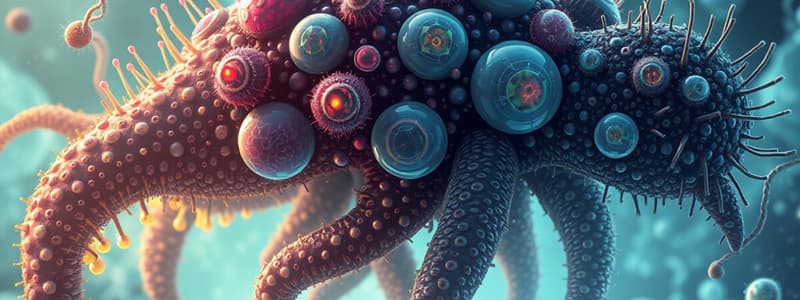Podcast
Questions and Answers
What does taxonomy study?
What does taxonomy study?
- Evolutionary relationships
- Ecological niches
- Principles of scientific classification (correct)
- Characteristics of organisms
What are taxa?
What are taxa?
Groups of organisms based on evolutionary relatedness
What is systematics (phylogeny)?
What is systematics (phylogeny)?
A discipline focused on classifying organisms and determining their evolutionary relationships
What is Eukarya?
What is Eukarya?
What is Bacteria?
What is Bacteria?
What characterizes Archaea?
What characterizes Archaea?
What are the three domains of life?
What are the three domains of life?
What are the three major groups of Archaea?
What are the three major groups of Archaea?
What is a molecular clock?
What is a molecular clock?
What is a genus?
What is a genus?
What is a specific epithet?
What is a specific epithet?
What is binomial nomenclature?
What is binomial nomenclature?
What is an eukaryotic species?
What is an eukaryotic species?
What is a family in biological classification?
What is a family in biological classification?
What is an order in taxonomy?
What is an order in taxonomy?
What is a class in biological classification?
What is a class in biological classification?
What is phylum in taxonomy?
What is phylum in taxonomy?
What is a kingdom in biological classification?
What is a kingdom in biological classification?
What is a domain?
What is a domain?
What is a prokaryotic species?
What is a prokaryotic species?
What is a clone?
What is a clone?
What is a strain in biological classification?
What is a strain in biological classification?
What is protista?
What is protista?
What are clades?
What are clades?
What is Fungi?
What is Fungi?
What does Plantae refer to?
What does Plantae refer to?
What is Animalia?
What is Animalia?
What is a viral species?
What is a viral species?
What are rapid identification methods?
What are rapid identification methods?
What is numerical identification?
What is numerical identification?
What is serology?
What is serology?
What is antiserum?
What is antiserum?
What is a slide agglutination test?
What is a slide agglutination test?
What is serological testing?
What is serological testing?
What are serotypes?
What are serotypes?
What are serovars?
What are serovars?
Flashcards are hidden until you start studying
Study Notes
Taxonomy and Classification
- Taxonomy involves the study of scientific classification principles.
- Taxa are groups of organisms classified based on evolutionary relationships.
- Systematics, or phylogeny, focuses on classifying organisms and their evolutionary connections.
Domains of Life
- Three primary domains: Eukarya, Bacteria, Archaea.
- Eukarya includes organisms with nuclei: protists, plants, fungi, animals.
- Bacteria consists of unicellular prokaryotes with peptidoglycan cell walls.
- Archaea are unicellular prokaryotes without peptidoglycan in their walls.
Archaea Subgroups
- Major groups of Archaea: methanogens, extreme halophiles, hyperthermophiles.
Taxonomic Hierarchy
- The hierarchy consists of several categories: domain, kingdom, phylum, class, order, family, genus, species.
- Genus groups one or more species; specific epithet is the second part of a scientific name, italicized and not capitalized.
- Binomial nomenclature uses two words for scientific names: genus followed by species.
Prokaryotic Characteristics
- Prokaryotic species are populations of similar unicellular organisms.
- Clones are genetically identical cells from a single original cell.
- Strains within prokaryotic species exhibit variations in characteristics.
Eukaryotic Kingdoms
- Protista is a kingdom of eukaryotes not classified as plants, animals, or fungi.
- Fungi obtain nutrients by decomposing organic material.
- Plantae are multicellular, green organisms using sunlight for photosynthesis, characterized by cellulose-based cell walls.
- Animalia consists of complex, multicellular organisms that lack cell walls and respond quickly to their environment.
Viruses and Identification Techniques
- Viral species are populations of viruses with similar traits in a specific ecological niche.
- Rapid identification methods, like Enterotube II and API, allow simultaneous biochemical tests for significant bacteria.
- Numerical identification assigns values to aid microorganism identification.
Serological Methods
- Serology studies blood serum and antibody-antigen interactions.
- Antiserum contains antibodies for specific pathogens.
- Slide agglutination tests mix antibodies with antigens on slides to observe agglutination.
- Serological testing analyzes antigen-antibody reactions in body fluids.
- Serotypes are antigenic variants identified by a singular typing serum.
Studying That Suits You
Use AI to generate personalized quizzes and flashcards to suit your learning preferences.




